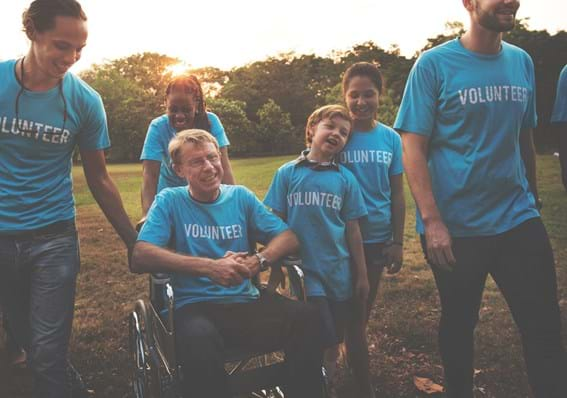Last week we explored the foundational framework upon which charity is built as we examined how traits of generosity, empathy and compassion lend themselves to the consideration of others. This week we will examine some practical ways kids can be actively involved in altruistic behaviour.
Teaching your children about managing their money should start at an early age. The ethics and responsibilities around the use of money is a critical part of this education and can also be introduced early on. Creating opportunities and sharing experiences with your child where money is used to help others is a gentle but powerful introduction to the concept of charity, teaching children to be generous and compassionate towards those in need.
Lead by example
Let your child know when you are supporting a charity or being generous in some way. To help build an emotional connection to charitable giving share with your child the reasons why you do it, and how it makes you feel when you do. Explain how you think your contributions will assist others.
If taking a bag of clothes to the local op shop, let your kid tag along and perhaps even add to the donations by going through their own outgrown clothes and old toys. Explain that your donations will be sorted through and eventually hung up or placed on the shelves with all the other items in the shop. Explain that when someone buys something from the store the proceeds go toward supporting the charity. Highlight also that in most cases the staff working at op shops are unpaid and working as a volunteer. In just one outing your child has already been exposed to the idea of physical donations, supporting a charity through a purchase and the concept of volunteering time to help a charity.

If passing a pop up stall raising money for a particular cause (such as Daffodil Day, or Legacy fundraisers), chat to your child about what they are raising money for and why they need the funds. I personally prefer to give a gold coin donation rather than buy the merchandise, but a pen or pin might be appealing to a young child. Ask the stall holder what particular campaign they are raising money for at the moment, and invite your child to ask questions to find out more.
The giant beige Guide Dog money boxes scattered around shopping malls (pretty sure they are the same ones from when I was a kid in the 80s) are a fun way to introduce charitable giving to a young child. Let them pop the coins into the money box slit and listen to it clutter to the bottom. Explain to your child the role of Guide Dogs and how they are a companion and a guide to assist those with blindness. Share the fact that money is needed to help pay for the breeding and training of the dogs.
Any one (or more) of these activities can be easily incorporated into a trip to the shops with your children. This simple task of dropping off excess possessions, chatting with a stall holder, or plopping a coin into a money box while out and about are easy ways to introduce the concept of being charitable to kids as young as 3 or 4.
Fundraising
Once your child starts school, fundraising becomes an easy way to involve them in charity work. Schools are always fundraising for something, be it a pie drive, Mother’s Day stall or mufti day so your child will have plenty of opportunities to hand over some cash to the school to support one thing or another. Our local school has a second hand clothing stall where 100% of the funds of each item purchased goes straight to the school. The lady who mends, washes and checks over each of the donations works purely as a volunteer. The school tuck shop also generates funds for the school, with all the staff volunteering their time so the school can make a profit from the pies and cookies they sell each day. While a school P&C isn’t a charity as such, it is still raising money for a good cause and is a good introduction to the concept of volunteering. Explain to your child what the school is raising money for in each instance and help them to understand what the extra money will mean to those receiving it.
Pocket Money
Most kids would agree that the idea of Mum and Dad giving their money to a charity is different to the child donating their own money. And yet, establishing this early on is one of the best introductions to charitable giving. For kids to choose to donate to a charity they will need their own money in the first place.

I can’t take credit for this idea, as it’s been suggested by a number of experts who write on charitable giving, but it is recommended that soon as your child begins to receive an allowance they be introduced to the concept of collecting funds for charity. It’s important to discuss the planned allocation of the funds from the very beginning. On my son’s 8th birthday (early September this year) he will begin receiving an allowance weekly. We plan to set up 3 jars in which to divvy up his pocket money and at this point have decided to keep pocket money inflation in line with age. So first up he’ll receive $8 per week. Of that $8, $2 will go into a jar for spending straight away and $2 will go into another jar for short term savings goals (so if he wants to save up for a new book or something he can save up over a few weeks and then buy the item). $3 will go straight into his Australian Mutual Bank Young Saver Account for long term savings goals, and $1 will go into a ‘charity’ jar. It might sound more complicated than handing over a $5 note but not only are you introducing charitable giving, you are also giving your child a maths lesson and early budgeting experience. When I first explained this whole concept to my son he said with a large grin he would be very happy to save up to support a good cause and even volunteered to put more than $1 in per week.
Younger kids might find the concept of donating money to a large faceless charity hard to appreciate without the first hand experience of what they are donating towards. Help them decide where they would like to donate their money. Perhaps they would prefer to support a local animal shelter and physically hand their donation to the staff and meet the animals. This makes the act of giving relatable plus the child can experience the positive emotional feedback of doing a good deed. Transferring funds over the internet with a credit card might not have the same ‘feel good’ benefits for a younger child.
Encouragement
Celebrate any small act of kindness or generosity your child demonstrates. Whether it’s donating one small toy or book to Vinnies, or wanting to help an injured bird in your garden. Talk about how they felt when they did the kind act and why they were motivated to do it in the first place. Discuss your own experiences as a child when you might have helped a stray animal or a person in need. Allow your child to help choose birthday and Christmas gifts for their friends and family. Choosing a gift for someone else gives the child an opportunity to put themselves in someone else’s shoes and see what the other person might need or want. Considering someone else’s desires or requirements is a powerful precursor to developing compassion and empathy.
Acknowledging even the smallest instinct to be generous will encourage these personal values to develop over time and eventually filter out into their lives as they grow up into considerate and charitable adults.

Alison Gallagher is a freelance writer, resourcefulness expert and entrepreneur. She has been featured in various publications including Stellar Magazine, Australian Health and Fitness Magazine, and Cleo Magazine. Alison is particularly passionate about sharing practical tips on how to live simply, sustainably and seasonally.






